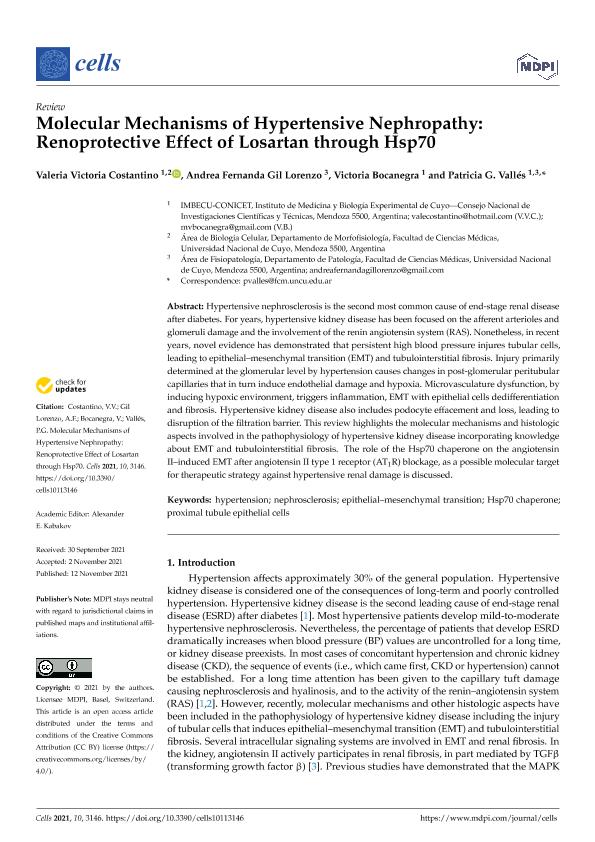Mostrar el registro sencillo del ítem
dc.contributor.author
Costantino, Valeria Victoria

dc.contributor.author
Gil Lorenzo, Andrea Fernanda

dc.contributor.author
Bocanegra, María Victoria

dc.contributor.author
Vallés, Patricia G.
dc.date.available
2022-09-19T15:29:00Z
dc.date.issued
2021-11
dc.identifier.citation
Costantino, Valeria Victoria; Gil Lorenzo, Andrea Fernanda; Bocanegra, María Victoria; Vallés, Patricia G. ; Molecular mechanisms of hypertensive nephropathy: Renoprotective effect of losartan through hsp70; Multidisciplinary Digital Publishing Institute; Cells; 10; 11; 11-2021; 3146-3162
dc.identifier.uri
http://hdl.handle.net/11336/169321
dc.description.abstract
Hypertensive nephrosclerosis is the second most common cause of end-stage renal disease after diabetes. For years, hypertensive kidney disease has been focused on the afferent arterioles and glomeruli damage and the involvement of the renin angiotensin system (RAS). Nonetheless, in recent years, novel evidence has demonstrated that persistent high blood pressure injures tubular cells, leading to epithelial–mesenchymal transition (EMT) and tubulointerstitial fibrosis. Injury primarily determined at the glomerular level by hypertension causes changes in post-glomerular peritubular capillaries that in turn induce endothelial damage and hypoxia. Microvasculature dysfunction, by inducing hypoxic environment, triggers inflammation, EMT with epithelial cells dedifferentiation and fibrosis. Hypertensive kidney disease also includes podocyte effacement and loss, leading to disruption of the filtration barrier. This review highlights the molecular mechanisms and histologic aspects involved in the pathophysiology of hypertensive kidney disease incorporating knowledge about EMT and tubulointerstitial fibrosis. The role of the Hsp70 chaperone on the angiotensin II–induced EMT after angiotensin II type 1 receptor (AT1R) blockage, as a possible molecular target for therapeutic strategy against hypertensive renal damage is discussed.
dc.format
application/pdf
dc.language.iso
eng
dc.publisher
Multidisciplinary Digital Publishing Institute
dc.rights
info:eu-repo/semantics/openAccess
dc.rights.uri
https://creativecommons.org/licenses/by/2.5/ar/
dc.subject
EPITHELIAL–MESENCHYMAL TRANSITION
dc.subject
HSP70 CHAPERONE
dc.subject
HYPERTENSION
dc.subject
NEPHROSCLEROSIS
dc.subject
PROXIMAL TUBULE EPITHELIAL CELLS
dc.subject.classification
Urología y Nefrología

dc.subject.classification
Medicina Clínica

dc.subject.classification
CIENCIAS MÉDICAS Y DE LA SALUD

dc.title
Molecular mechanisms of hypertensive nephropathy: Renoprotective effect of losartan through hsp70
dc.type
info:eu-repo/semantics/article
dc.type
info:ar-repo/semantics/artículo
dc.type
info:eu-repo/semantics/publishedVersion
dc.date.updated
2022-09-05T16:04:56Z
dc.identifier.eissn
2073-4409
dc.journal.volume
10
dc.journal.number
11
dc.journal.pagination
3146-3162
dc.journal.pais
Suiza

dc.journal.ciudad
Basilea
dc.description.fil
Fil: Costantino, Valeria Victoria. Consejo Nacional de Investigaciones Científicas y Técnicas. Centro Científico Tecnológico Conicet - Mendoza. Instituto de Medicina y Biología Experimental de Cuyo; Argentina. Universidad Nacional de Cuyo. Facultad de Ciencias Médicas. Instituto de Fisiología; Argentina
dc.description.fil
Fil: Gil Lorenzo, Andrea Fernanda. Consejo Nacional de Investigaciones Científicas y Técnicas. Centro Científico Tecnológico Conicet - Mendoza; Argentina. Universidad Nacional de Cuyo. Facultad de Ciencias Médicas. Instituto de Fisiología; Argentina
dc.description.fil
Fil: Bocanegra, María Victoria. Consejo Nacional de Investigaciones Científicas y Técnicas. Centro Científico Tecnológico Conicet - Mendoza. Instituto de Medicina y Biología Experimental de Cuyo; Argentina
dc.description.fil
Fil: Vallés, Patricia G.. Consejo Nacional de Investigaciones Científicas y Técnicas. Centro Científico Tecnológico Conicet - Mendoza. Instituto de Medicina y Biología Experimental de Cuyo; Argentina. Universidad Nacional de Cuyo. Facultad de Ciencias Médicas. Instituto de Fisiología; Argentina
dc.journal.title
Cells
dc.relation.alternativeid
info:eu-repo/semantics/altIdentifier/url/https://www.mdpi.com/2073-4409/10/11/3146
dc.relation.alternativeid
info:eu-repo/semantics/altIdentifier/doi/http://dx.doi.org/10.3390/cells10113146
Archivos asociados
